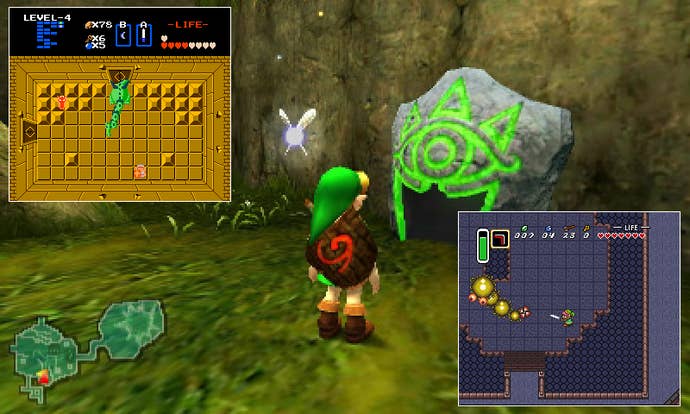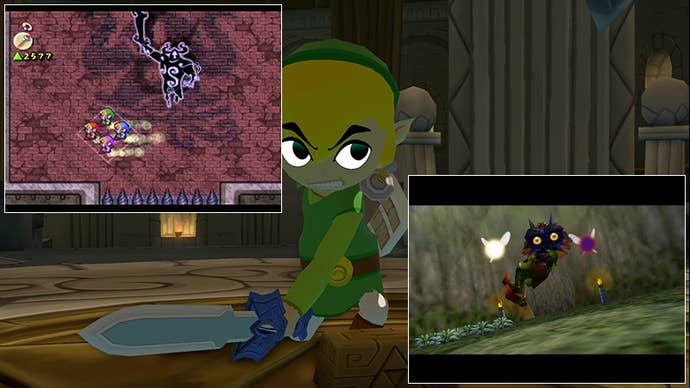Who Makes the Best Zelda Games?
Many minds have contributed to the Zelda franchise, but whose work holds up best?
This article first appeared on USgamer, a partner publication of VG247. Some content, such as this article, has been migrated to VG247 for posterity after USgamer's closure - but it has not been edited or further vetted by the VG247 team.
A while back, we asked, "Who makes the best Mario games?" When it comes to long-running franchises, the creative minds behind the games we love change over time, or the brands end up being lent away for other teams and companies to dabble in. While the Zelda franchise doesn't offer anywhere near as extensive a discography as Mario, this particular pie has nevertheless seen quite a number of different fingers poking at it over the years.
So who makes the best Zelda games? Well, you tell us. We've condensed the groups responsible for the full run of original Zelda games (remakes, like Grezzo's Ocarina of Time 3D, excluded) into a handy list, including pros and cons. It's not an easy question to answer, and we're interested to hear your thoughts. Who's your pick?

Nintendo Entertainment Analysis & Development (under Miyamoto)
Nintendo's EAD division handled Zelda from its inception in 1986 up until Nintendo's big internal reorganization about 10 years ago. This is where Zelda began, under the direction of designer Shigeru Miyamoto. However, after Ocarina of Time, Miyamoto stepped back somewhat from the Zelda series and let Ocarina's co-director, Eiji Aonuma, take lead duties on the series. The following games are those that were overseen by Miyamoto in a direct role rather than a more advisory capacity.
Zelda titles created: The Legend of Zelda (NES, 1986); Zelda II: The Adventure of Link (NES, 1987); The Legend of Zelda: A Link to the Past (SNES, 1992); The Legend of Zelda: Link's Awakening (Game Boy, 1994); The Legend of Zelda: Ocarina of Time (N64, 1998)
The case for: Well, this should be obvious. Without Miyamoto's EAD team, Zelda wouldn't exist. The entire series got its start here; not only that, but several of these games (notably A Link to the Past and Ocarina of Time) established a template that defines the structure of the games even now. Miyamoto's Zelda creations are true classics of the medium, and often could be quite unconventional (see: Link's Awakening).
The case against: Well, most of these games are classics, anyway. As with many older games, not every classic Zelda has aged well. The NES games can feel needlessly oblique, particularly Zelda II, which comes off like a game designed in part to help sell strategy guides.
Animation Magic
A rare instance of Nintendo outsourcing Zelda, Animation Magic's pair of adventures came into existence entirely for political reasons. Basically, Nintendo backed out of a deal with Sony and teamed up with Philips instead, and the result of that fruitless union was a handful of licensed Zelda and Mario games. They are widely regarded as terrible.
Zelda titles created: Link: The Faces of Evil (CDi, 1993); Zelda: The Wand of Gamelon (CDi; 1993)
The case for: The bizarre, overanimated cut scenes of these games is great for a laugh.
The case against: Terrible art, music, story, and game design. Nintendo doesn't even acknowledge these games' existence, and for good reason.
Viridis
The second studio to get their hands on Zelda as a result of the Philips deal, Viridis actually didn't do too completely terrible a job with the property. Their creation certainly wasn't the dire garbage that Animation Magic churned out.
Zelda titles created: The Legend of Zelda: Zelda's Adventure (CDi, 1993)
The case for: While they only created a single game that Nintendo has disavowed, Viridis' take on Zelda was actually pretty faithful – and, it should be noted, marks one of the few episodes in the entire franchise in which Princess Zelda herself takes up her sword to save the day (and not just as a supporting character).
The case against: Still nowhere near as polished as a "true" Zelda game, you can certainly argue the case that Zelda's Adventure only seems good by comparison to its abysmal CDi peers. Those load times...!

Nintendo Entertainment Analysis & Development (under Aonuma)
After Ocarina of Time, Shigeru Miyamoto handed the keys to the kingdom (that is, Hyrule) over to Eiji Aonuma, who has served as the series' creative lead ever since. Although his stint as Zelda boss under the auspices of Nintendo EAD were fairly short, the handful of games his team created were all quite strong.
Zelda titles created: The Legend of Zelda: Majora's Mask (N64, 2000); The Legend of Zelda: The Wind Waker (GameCube, 2003); The Legend of Zelda: Four Swords Adventure (GameCube, 2003)
The case for: This may actually be the most experimental three years of Zelda ever. Majora's Mask operated by means of an unconventional time-loop structure; the Wind Waker adopted an almost entirely open-world structure that, in hindsight, seems to have been well ahead of its time; and Four Swords Adventure expanded on a promising but inadequately explored (to mention largely overlooked) concept to properly realize the vision of multiplayer Zelda. There's not a false step in this batch of games.
The case against: This period represents only a small sliver of time, and these games' experimental nature also means they don't represent what many people see as the "true" Zelda style.
Flagship
Around the turn of the millennium, Nintendo contracted out several portable Zelda games to a division of Capcom called Flagship. These games generally seemed to pattern themselves after notable main line releases; Oracle of Ages resembles Ocarina of Time, Oracle of Seasons the original Zelda, etc.
Zelda titles created: The Legend of Zelda: Oracle of Ages (GBC, 2001); The Legend of Zelda: Oracle of Seasons (GBC, 2001); The Legend of Zelda: The Four Swords (GBA, 2002); The Legend of Zelda: The Minish Cap (GBA, 2004)
The case for: Unlike the Philips debacle, this trilogy of adventures didn't evoke a sense of regret and failure from the decision to license them out. Flagship's work can stand toe-to-toe with just about any chapter of the Zelda series, and arguably these titles feel a lot more faithful to the spirit of the franchise than the subsequent portable games for DS. The Oracle duology in particular pulls a rather brilliant trick: The two games can be played in either order, but whichever you play second will reveal the story's "true" ending. Meanwhile, Four Swords may have been a mere bonus mode, but it cracked the puzzle of how to incorporate satisfying multiplayer into the Zelda style.
The case against: Some feel Flagship's titles lack a certain spark of innovation and polish. And the group overstepped its capabilities; the Oracles games were originally meant to be a trilogy but were scaled back once Flagship realized it didn't have the resources or clarity of design to execute their bold plan.

Nintendo Software Development Group 3
Around the time Satoru Iwata took control of Nintendo in the wake of Hiroshi Yamauchi's retirement, the entire company undertook a massive reorganization. Aonuma's team, formerly of EAD, ended up in its own separate division: Software Development Group 3. It's here that the past decade's worth of Zelda games have been crafted, and where the future of the series is currently being defined.
Zelda titles created: The Legend of Zelda: Twilight Princess (Wii/GameCube, 2006); The Legend of Zelda: Link's Crossbow Training (Wii, 2007); The Legend of Zelda: Phantom Hourglass (DS, 2007); The Legend of Zelda: Spirit Tracks (DS, 2009); The Legend of Zelda: Skyward Sword (Wii, 2011); The Legend of Zelda: A Link Between Worlds (3DS, 2013)
The case for: There have been some real Zelda gems published under the auspices of SDG3. Most recently, A Link Between Worlds inverted the traditional Zelda sequel technique of creating new settings for a familiar structure of progression, instead recycling A Link to the Past's setting in order to take a totally new approach to the quest concept. The DS games experimented with mechanics and interface design in order to create fundamentally accessible adventures that still felt truly Zelda-like. And Twilight Princess and Skyward Sword, for all the flack they take, easily rank as the two largest and most epic chapters of the entire series.
The case against: There can be a real sense of wheels being spun in contemporary Zelda games; the console titles tend to play it a little too conservative, while the portable games throw out a lot of assumptions in an attempt to appeal to the masses. Zelda's still great... but is it as great as it used to be?


